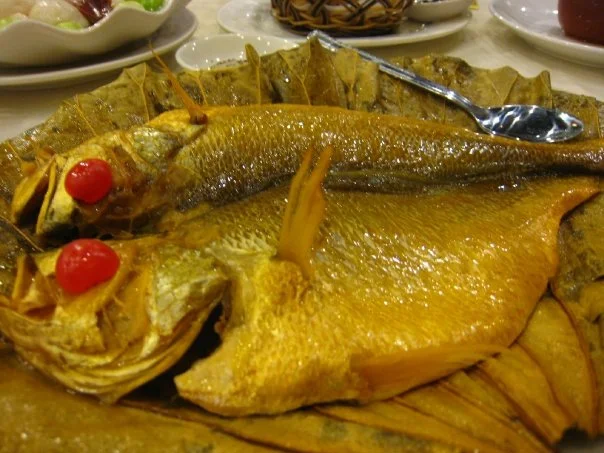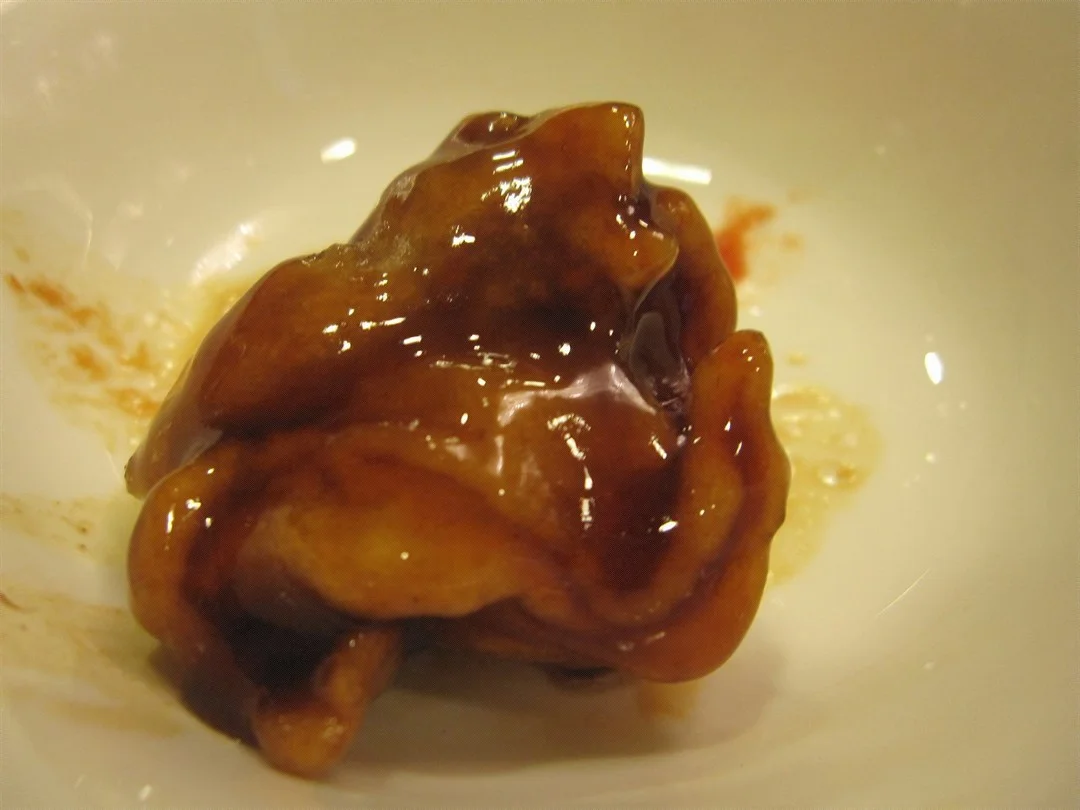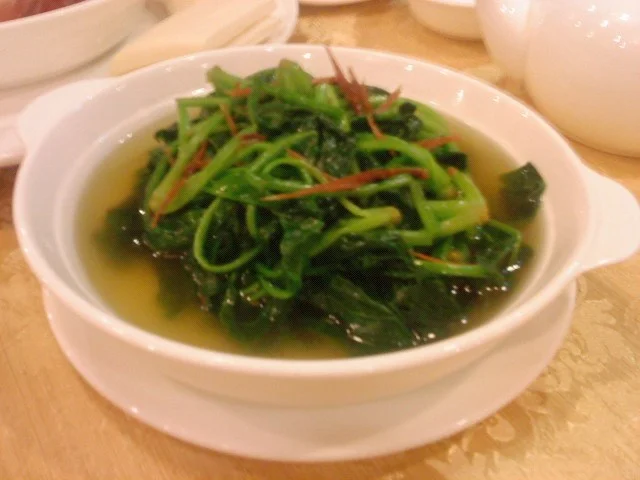The manager suggested a series of 8 starters, as is traditional. The main dishes were pre-ordered.
Evergreen with dried bamboo shoots (筍乾萬年青) - not sure exactly which veggie this is, but there is a distinct fragrance which is milder than that of Indian aster (馬蘭頭). This may in fact contain rape flowers (油菜花) as some references indicate. There was some shredded dried bamboo shoots to mix things up a little.
House special marinated duck (招牌醬鴨) - this was OK.
Drunken pigeon (花雕醉鴿) - this was very good. I specifically picked one of the pieces which was still a little rare... very tender.
Hangzhou-style vegetarian goose (杭州素鵝) - kinda different from all the vegetarian goose/chicken I've had before. Unlike some versions where the tofu skin has been made into one block with bite, nor were the many layers deep-fried into a crunchy state. Instead this was wet and soft, and slightly spongy.
Marinated cucumber and jellyfish head (青瓜海蜇頭) - this was OK.
Marinated black fungus (拌木耳) - this was OK.
Honey-marinated lotus root stuffed with glutinous rice (糯米蓮藕) - this has always been one of my favorites since childhood. Yum...
Blanched pig's kidney (搶腰花) - not bad at all.
Then the main dishes started arriving...
River shrimps stir-fried with Longjing tea leaves (龍井蝦仁) - I have never had a version of this dish that lived up to my expectations, and I've stopped ordering this at Tien Heung Lau. Maybe I just don't "get" this dish, but I had always been expecting delicate fragrance from the tea leaves on my palate, from the descriptions written by countless others. This has always eluded me, and I end up thinking that the tea leaves are there simply for show. Are the leaves meant to cancel out any unwanted flavors from the shrimps, instead of providing a more prominent fragrance? Is my palate so poor that I cannot detect the fragrance that many others seem to have encountered?
Deep-fried tofu bells (乾炸響鈴) - this was absolutely amazing, and I think I had 3 or maybe 4 of these... The thin layers of tofu skin were deep-fried in high heat, and became so crispy that it just crumbled in one's mouth. This reminds me of some of the croissants one finds in pâtisseries -such as Blé Sucré in Paris - where lots of butter was used, as these would also crumble under pressure.
Deep-fried stinky tofu (炸臭豆腐) - the other half of the crispy golden duo (黃金雙脆). Normally I'd stay as far away from stinky tofu as possible, and it's one of the very few things I don't like to eat. But I've learned two things over the years... the deep-fried version smells a lot less than the steamed version; and like durian, the smell ain't so bad when you are eating it yourself. I took one tonight, and found the flavors to be a lot milder than the smell. Honestly a lot of cheese that I take in regularly are more pungent than this...
Braised Dong Po pork belly (東坡肉) - this is one dish where the son outshone the father. I have always found this dish to be a complete failure at Tien Heung Lau, and have always been amazed how that restaurant could screw up one of the most popular dishes in Shanghainese food. Tonight I really enjoyed my pork belly, sandwiching it between layers of steamed bun. The flavors from the marinade were able to penetrate into the whole piece of pork, and more importantly the lean meat was still succulent instead of being completely dry and tough.
Smoked yellow croaker (煙燻黃魚) - what's with the cherries on the eyes? This was one of the most anticipated dishes of the evening, as we all love the one at Tien Heung Lau. I was not disappointed, as there was plenty of smoky flavors and fragrance. I found the flesh to be a bit more flavorful than Tien Heung Lau's version. I happily had seconds and thirds, including cleaning up the tail...
Smoked frog's legs (煙燻田雞腿) - the smoky fragrance was nice, but I much prefer the deep-fried frog's legs at Tien Heung Lau.
Fish balls with watershield (蒓菜魚圓) - they are famous for their fish balls and I can see why. These were very light and fluffy, unlike many of the Cantonese fish balls which have a lot more bite. The watershield (蒓菜) is grown in areas like West Lake (西湖) in Hangzhou (杭州), although it's also found in Japanese cuisine. They've got this slippery mucus on the outside which makes it interesting.
Steamed Reeve's shad (清蒸鰣魚) - a request from one of the diners, as it's impossible to find in Singapore. This was a pretty big one, and it's been a while since I've had the whole fish instead of just half... The manager did too good of a job of separating the scales from the skin, so the scales were pretty clean and only had some of the vinegar/wine sauce for me to suck on. This was pretty good... We had to warn the uninitiated to watch for the incredible amount of bones hidden in the flesh. It's always a lot of work to taste this fish, but I love it.
Double-boiled old duck soup (火燑老鴨煲) - what a lovely soup! Old ducks are always used in soup for their flavors, and complemented the strong flavors of the ham very well. Made with some preserved bamboo shoots (扁尖筍) which were a little hard and chewy.
Beggar's chicken (富貴童雞) - finally! A beggar's chicken where the meat is moist and tender! While the fragrance here may not have been as impressive as the one at Tien Heung Lau, the chicken meat was definitely a lot better, with more flavors, too. Very happy with this.
I think we were all full by this point, but some of the group were clearly unsatiated, and there was an itch that needed scratching. So an order was put in for hairy crab roe noodles (蟹粉撈麵), which is a favorite at Tien Heung Lau. While we received generous portions of crab roe, the brownish color tells me that the quality isn't as good as what we'd get at Tien Heung Lau (where the roe is bright orange). The round noodles were also a bit overcooked with soy sauce, and were not the best complement to the roe.
The complimentary dessert was a bowl of glutinous rice balls in fermented rice with osmanthus (桂花酒釀湯圓). They used a lot of osmanthus sauce so it was very fragrant, and it wasn't overly sweet.
original blogpost with pictures and wine notes: http://www.diarygrowingboy.com/2011/03/hk-chowmeet-2011-part-1-hangzhou-style.html
 酒香淡而清澈, 肉質也嫩, 但少一點鴿香, 可能同依家用雪藏鴿有關. 肉質鮮嫩, 有咬口, 不是梅林林的, 無咩骨所以口中的障礙很少.
酒香淡而清澈, 肉質也嫩, 但少一點鴿香, 可能同依家用雪藏鴿有關. 肉質鮮嫩, 有咬口, 不是梅林林的, 無咩骨所以口中的障礙很少.

 蘇杭菜與上海菜相似, 除冷盤外, 一般菜式比較油膩而濃味. 這家店已經地道化左一部分. 用夾餅配以東坡肉可以減低油膩的口感, 但對我而言, 唔夾餅仲好食呀! 但可能因為要夾餅的關係, 師傅響個汁的調教偏向鹹少少. 但肥肉鬆化非常, 肥膏的香味滲進口中每個角落, 下面的瘦肉亦很林, 與肥膏混合, 有一種粘粘的感覺.
蘇杭菜與上海菜相似, 除冷盤外, 一般菜式比較油膩而濃味. 這家店已經地道化左一部分. 用夾餅配以東坡肉可以減低油膩的口感, 但對我而言, 唔夾餅仲好食呀! 但可能因為要夾餅的關係, 師傅響個汁的調教偏向鹹少少. 但肥肉鬆化非常, 肥膏的香味滲進口中每個角落, 下面的瘦肉亦很林, 與肥膏混合, 有一種粘粘的感覺.
 脆口軟身, 係唔錯的選擇. 可能由細響街邊食大, 所以我都係嫌佢唔夠臭. 不過依家都好少會有好臭的臭豆腐啦, 所以都係覺得依家d小朋友無以前咁幸福.
脆口軟身, 係唔錯的選擇. 可能由細響街邊食大, 所以我都係嫌佢唔夠臭. 不過依家都好少會有好臭的臭豆腐啦, 所以都係覺得依家d小朋友無以前咁幸福.

 真係好好食! 條魚未黎到已經嗅到煙熏香味, 有一種烤木的感覺. 從表面上見到條魚係充滿黃油的, 可見魚身本來已經好肥美. 放入口魚肉嫩滑, 一絲絲慢慢瓦解, 口中唔會有多餘的殘渣. 魚鮮味同肥油香再加上煙熏的木醬香味, 令我好少食魚的人都好難抗拒, 真係好!
真係好好食! 條魚未黎到已經嗅到煙熏香味, 有一種烤木的感覺. 從表面上見到條魚係充滿黃油的, 可見魚身本來已經好肥美. 放入口魚肉嫩滑, 一絲絲慢慢瓦解, 口中唔會有多餘的殘渣. 魚鮮味同肥油香再加上煙熏的木醬香味, 令我好少食魚的人都好難抗拒, 真係好!
 據我了解, 呢間店的大廚係天香樓大廚的兒子. 講到天香樓, 一定都係蟹粉拌麵, 裡面的蟹粉有如黃金一樣的色相, 亦如黃金一樣的價錢. 而我又見到呢間店餐牌上有蟹粉拌麵, 所以必定要試試. 價錢方面, 單看這碗如酒樓白粥大的麵已經要收$250.
據我了解, 呢間店的大廚係天香樓大廚的兒子. 講到天香樓, 一定都係蟹粉拌麵, 裡面的蟹粉有如黃金一樣的色相, 亦如黃金一樣的價錢. 而我又見到呢間店餐牌上有蟹粉拌麵, 所以必定要試試. 價錢方面, 單看這碗如酒樓白粥大的麵已經要收$250. Video
Video























































